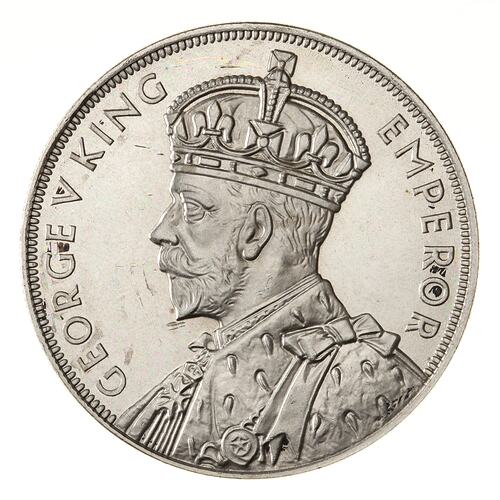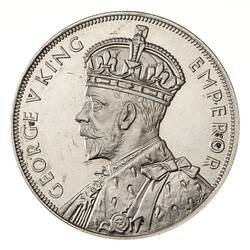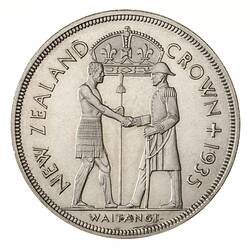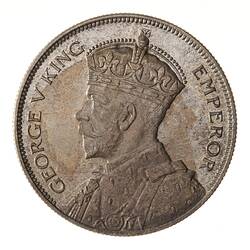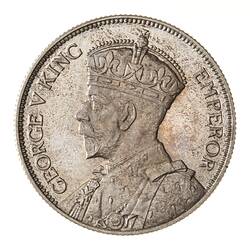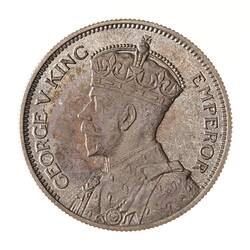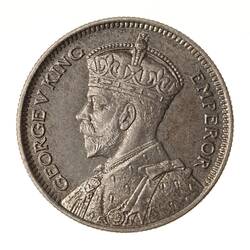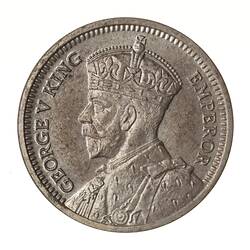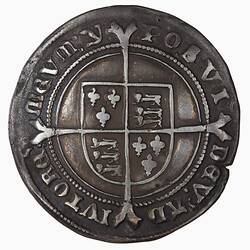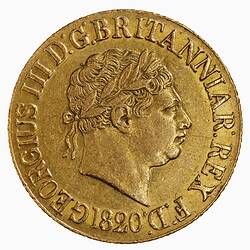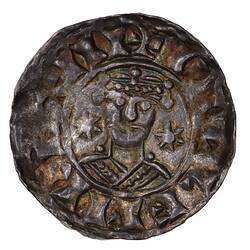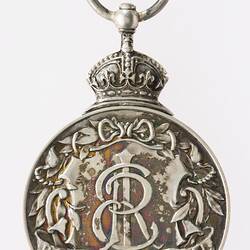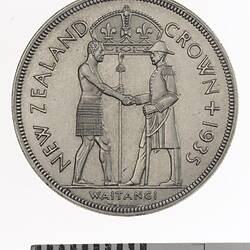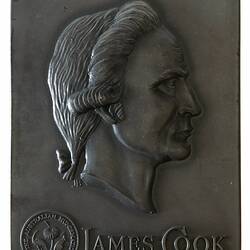Summary
Proof Crown (5 Shillings), Issued by New Zealand, 1935
Known as the Waitangi Crown
Minted by Royal Mint, London
New Zealand's most famous coin. Issued to commemorate the signing of the 1840 Treaty of Waitangi - New Zealand's founding document. Struck from silver at the Royal Mint, London. The mintage was only 1,128 coins.
Obverse Description
Crowned bust of George V facing left (extends to rim); around, GEORGE V KING EMPEROR (by Percy Metcalf)
Reverse Description
Below a large crown Chief Tamati Waka Nene, on left, and Captain William Hobson, on right, shake hands; around, NEW ZEALAND CROWN + 1935; in exergue, WAITANGI
Edge Description
MIlled
Significance
This coin was struck to commemorate the signing of the Treaty of Waitangi on 6 February 1840. Chief Tamati Waka Nene is described in the Annual Report of the Royal Mint, 1934 as 'one of the paramount chiefs of the time, who was largely instrumental in persuading his fellow chiefs to sign the Treaty'. He is depicted shaking hands with Captain William Hobson, the Lieutenan- Governor. The Treaty was written shortly before it was signed and translated into Maori on 4th February for consideration by about 500 Maori people. On the 6th. February about 40 chiefs signed the Maori version of the document starting with Hone Heke. Copies of the document were then sent around the country and by September 1840 about 500 more chiefs had signed.
'The Treaty is a broad statement of principles on which the British and Maori made a political compact to found a nation state and build a government in New Zealand. The Treaty has three articles. In the English version, these are that Maori ceded the sovereignty of New Zealand to Britain; Maori gave the Crown an exclusive right to buy lands they wished to sell, and, in return, they were guaranteed full rights of ownership of their lands, forests, fisheries and other possessions; and that Maori would have the rights and privileges of British subjects.'
From 'The Treaty in brief', URL: http://www.nzhistory.net.nz/politics/treaty/the-treaty-in-brief, (Ministry for Culture and Heritage), updated 12-Feb-2011
The coin was not issued to mark a particular anniversary of the signing of the Treaty, nor, as is sometimes suggested, was it to commemorate the Silver Jubilee of George V which occurred in 1935.
More Information
-
Collecting Areas
-
Acquisition Information
Transfer from Melbourne Branch of Royal Mint, 1978
-
Date Issued
1935 AD
-
Issued By
-
Mint
-
Artist
Reginald G. Berry, New Zealand
Biographies of Berry suggest this was done in 1934 or 35 however the 1934 Annual Report of the Royal Mint states that sketches were recieved from New Zealand for the 1933 coinage (including the crown) in 1933 and that Kruger Gray who had designed a series of coins for New Zealand and recieved approval from the Prime Minister earlier in 1933 had to start over with the new concepts. The crown was delayed until 1935 with the dies being by Percy Metcalf. -
Artist
-
Denomination
-
Series
-
Material
Silver
-
Axis
12
-
Classification
-
Category
-
Discipline
-
Type of item
-
Dimensions
38 mm (Outside Diameter), 28.28 g (Weight)
-
Shape
Round
-
References
KM#6 Sixty-fourth Annual Report of the Deputy Master and Comptroller of the Royal Mint 1933, p.8 Sixty-fifth Annual Report of the Deputy Master and Comptroller of the Royal Mint 1934, p.13-14Stacks bowers Ponteiro to Offer superb Waitangi Proof Set At ANA. Australasian Coin & Banknote July 2012 p. 54-5
[Book] Bruce, Colin R. 2009. 2009 Standard Catalogue of World Coins 1901 - 2000., 1540 Pages
-
Keywords
British Empire Coins, Maori Culture, Maoris, Waitangi Treaty, 1840, British Commonwealth and Empire Coins
